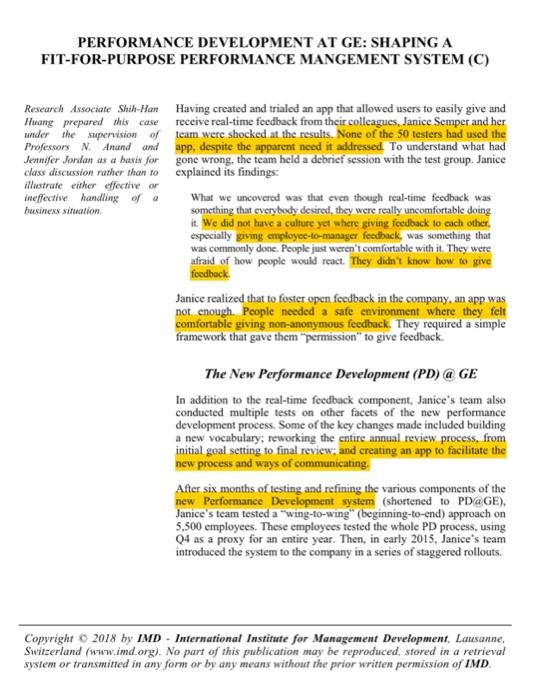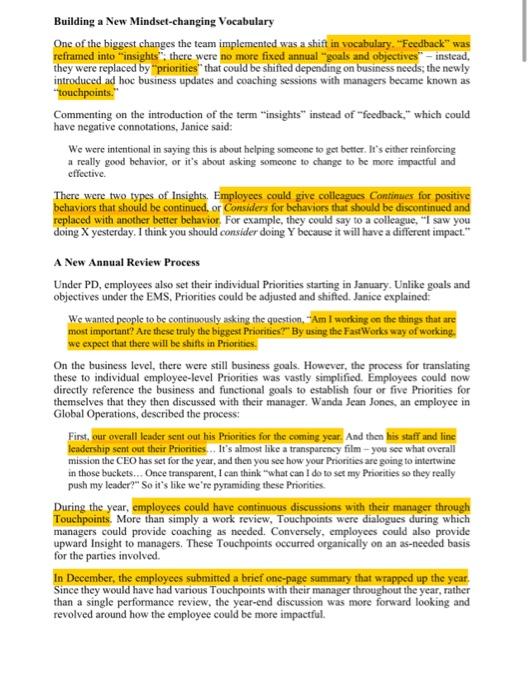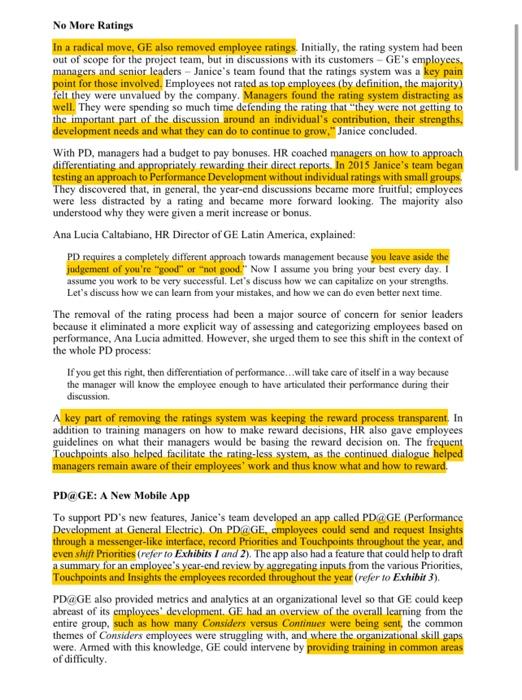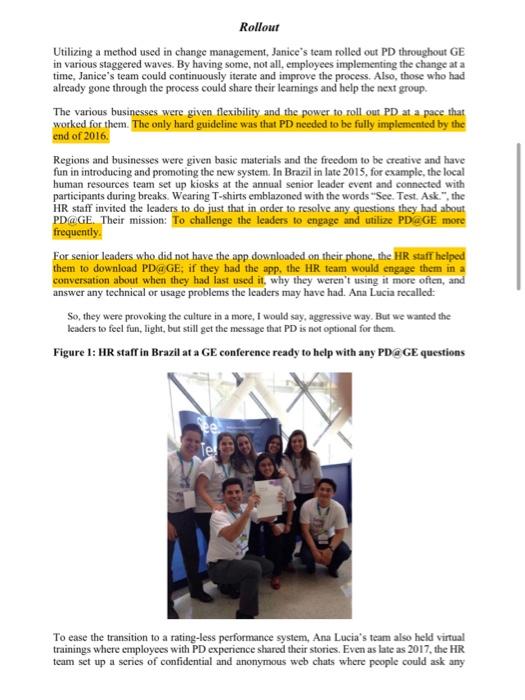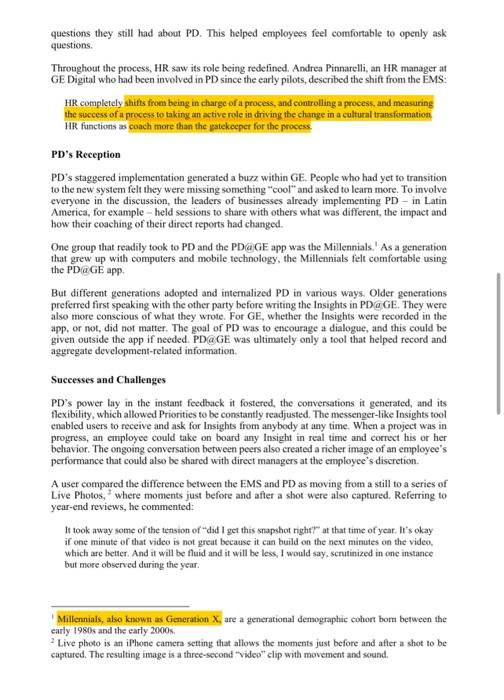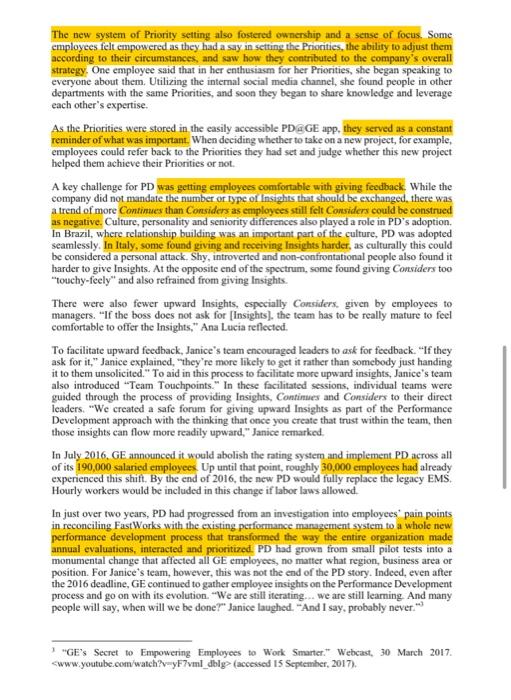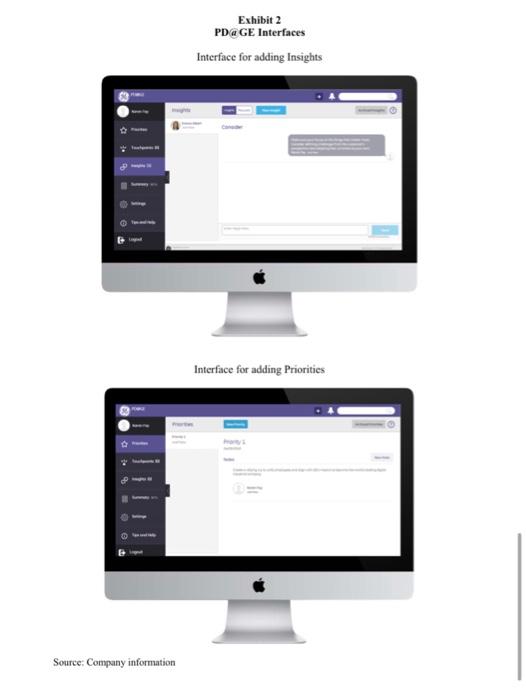A well-written report about the uploded article, it should contain the following elements:
1. Executive summary. This is a concisely written statement, less than one page, placed at the front of the report. It briefly summarizes the major points of the case and your solution. It should describe the major issue, the proposed solution, and the logic supporting the solution.
2. Problem statement. Present the central issue(s) or major problem(s) in the case here. Do not rehash the facts of the case; assume that anyone reading the report is familiar with the case.
3. Alternatives. Discuss all relevant alternatives. Briefly present the major arguments for and against each alternative. Be sure to state your assumptions and the impact of constraints on each alternative.
4. Conclusion. Present the analysis and the logic that led you to select a particular solution. Also discuss the reasons you rejected the other alternatives.
5. Implementation. Outline a plan of action that will lead to effective implementation of the decision so that the reader can see not only why you chose a particular alternative but how it will work.
PERFORMANCE DEVELOPMENT AT GE: SHAPING A FIT-FOR-PURPOSE PERFORMANCE MANGEMENT SYSTEM (C) Research Associate Shih-Han Huang prepared this case under the supervision of Professors N, Anand and Jennifer Jondan as a bavis for class discussion rather than to illustrate either effective or ineffective handling of a business situation, Having created and trialed an app that allowed users to easily give and receive real-time feedback from their colleagues, Janice Semper and her team were shocked at the results. None of the 50 testers had used the app, despite the apparent need it addressed. To understand what had gone wrong, the team held a debrief session with the test group. Janice explained its findings: What we uncevered was that even though real-time feedback was something that everybody desired, they were really uncomfortable doing it. We did not have a culture yet where giving feedoack to each other, especially giving employee-to-manager feedback, was something that was commonly done. People just weren't comfortable with it They were afraid of how people would react. They didn't know bow to give feodback. Janice realized that to foster open feedback in the company, an app was not enough. People needed a safe environment where they felt comfortable giving non-anonymous feedback. They required a simple framework that gave them "permission" to give feedback. The New Performance Development (PD) (GE In addition to the real-time feedback component, Janice's team also conducted multiple tests on other facets of the new performance development process. Some of the key changes made included building a new vocabulary; reworking the entire annual review process, from initial goal setting to final review; and creating an app to facilitate the new process and ways of communicating. After six months of testing and refining the various components of the new Performance Development system (shortened to PDaGE ), Janice's team tested a "wing-to-wing" (beginning-to-end) approach on 5,500 employees. These employees tested the whole PD process, using Q4 as a proxy for an entire year. Then, in early 2015, Janice's team introduced the system to the company in a series of staggered rollouts. Copyright 02018 by IMD - International Institute for Management Development, Lausanne, Switzerland (wwwimd.org). No part of this publication may be reproduced, stored in a retrieval system or transmitted in any form or by any means without the prior written permission of IMD. Building a New Mindset-changing Vocabulary One of the biggest changes the team implemented was a shift in vocabulary. "Fecdback" was reframed into "insights"; there were no more fixed annual "goals and objectives" - instead, they were replaced by "priorities" that could be shifted depending on business needs; the newly introduced ad hoc business updates and coaching sessions with managers became known as "touchpoints." Commenting on the introduction of the term "insights" instead of "feedback," which could have negative connotations, Janice said: We were intentional in saying this is about helping someone to get better. It's either reinforcing a really good behavior, or it's about asking someone to change to be more impactful and effective. There were two types of Insights. Employees could give colleagues Contiruies for positive behaviors that should be continued, or Considers for behaviors that should be discontinued and replaced with another better behavior. For example, they could say to a colleague, "I saw you doing X yesterday. 1 think you should consider doing Y because it will have a different impact." A New Annual Review Process Under PD, employees also set their individual Priorities starting in January. Ualike goals and objectives under the EMS, Priorities could be adjusted and shifted. Janice explained: We wanted people to be continuously acking the question, 4AmI working on the things that are most important? Are these truly the biggest Priorities?" By using the FastWorks way of working. we expect that there will be shifts in Priorities. On the business level, there were still business goals. However, the process for translating these to individual employee-level Priorities was vastly simplified. Employees could now directly reference the business and functional goals to establish four or five Priorities for themselves that they then discussed with their manager. Wanda Jean Jones, an employee in Global Operations, described the process: First, our overall leader sent out his Priorities for the coming year. And then his staff and line leadership sent out their Prionties... It's almost like a transparency film - you see what overall mission the CEO has set for the year, and then you see how your Priorities are going to intertwine in those buckets... Once transparent, 1 can think "what can I do to set my Prictities so they really push my leader?" So it's like we're pyramiding these Priorities. During the year, employees could have continuous discussions with their manager through Touchpoints. More than simply a work review, Touchpoints were dialogues during which managers could provide coaching as needed. Conversely, employees could also provide upward Insight to managers. These Touchpoints occurred organically on an as-needed basis for the parties involved. In December, the employees submitted a brief one-page summary that wrapped up the year. Since they would have had variots Touchpoints with their manager throughout the year, rather than a single performance review, the year-end discussion was more forward looking and revolved around how the employee could be more impactful. No More Ratings In a radical move, GE also removed employee ratings. Initially, the rating system had been out of scope for the project team, but in discussions with its customers - GE's employees, managers and senior leaders - Janice's team found that the ratings system was a key pain point for those involved. Employees not rated as top employees (by definition, the majority) felt they were unvalued by the company. Managers found the rating system distracting as well. They were spending so mueh time defending the rating that "they were not getting to the important part of the discussion around an individual's contribution, their strengths, development needs and what they can do to continue to grow," Janice concluded. With PD, managers had a budget to pay bonuses. HR coached managers on how to approach differentiating and appropriately rewarding their direct reports. In 2015 Janice's team began testing an approach to Performance Development without individual ratings with small groups. They discovered that, in general, the year-end discussions became more fruitful; employees were less distracted by a rating and became more forward looking. The majority also understood why they were given a merit increase or bonus. Ana Lucia Caltabiano, HR Director of GE Latin America, explained: PD requires a completely different approach towards management because you leave aside the judgement of you're "good" or "not good." Now I assume you bring your best every day. I assume you work to be very suceessful. Let's discuss bow we can capitalizc on your strengths. Let's discuss how we can learn from your mistakes, and bow we can do even better next time. The removal of the rating process had been a major source of concern for senior leaders because it eliminated a more explicit way of assessing and categorizing employees based on performance, Ana Lucia admitted. However, she urged them to see this shift in the context of the whole PD process: If you get this right, then differentiation of performance..will take care of itself in a way because the manager will know the employee enough to have articulated their performance during their discussion. A key part of removing the ratings system was keeping the reward process transparent. In addition to training managers on how to make reward decisions, HR also gave employees guidelines on what their managers would be basing the reward decision on. The frequent Touchpoints also helped facilitate the rating-less system, as the continued dialogue helped managers remain aware of their employees' work and thus know what and how to reward. PD@GE: A New Mobile App To support PD's new features, Janice's team developed an app called PDaGE (Performance Development at General Electric). On PD a GE, employees could send and request Insights through a messenger-like interface, record Priorities and Touchpoints throughout the year, and even shiff Priorities (refer to Exhibits I and 2). The app also had a feature that could help to draft a summary for an employee's year-end review by aggregating inputs from the various Priorities, Touchpoints and Insights the employees recorded throughour the year (refer to Exhibit 3). PDaGE also provided metrics and analytics at an organizational level so that GE could keep abreast of its employees' development. GE had an overview of the overall learning from the entire group, such as how many Considers versus Continues were being sent, the common themes of Considers employees were struggling with, and where the organizational skill gaps were. Armed with this knowledge, GE could intervene by providing training in common areas of difliculty. Rollout Utilizing a method used in change management, Janice's team rolled out PD throughout GE in various staggered waves. By having some, not all, employees implementing the change at a time, Janice's team could continuously iterate and improve the process. Also, those who had already gone through the process could share their leamings and help the next group. The various businesses were given flexibility and the power to roll out PD at a pace that worked for them. The only hard guideline was that PD needed to be fully implemented by the end of 2016. Regions and businesses were given basic materials and the freedom to be creative and have fun in introducing and promoting the new system. In Brazil in late 2015, for example, the local human resources team set up kiosks at the annual senior leader event and connected with participants during breaks. Wearing T-shirts emblazoned with the words "See. Test. Ask.", the HR staff invited the leaders to do just that in order to resolve any questions they had about PDaGE. Their mission: To challenge the leaders to engage and utilize PD&GE more frequently. For senior leaders who did not have the app downloaded on their phone, the HR stafr helped them to download PDaGE; if they had the app, the HR team would engage them in a conversation about when they had last used it, why they weren't using it more often, and answer any technical or usage problems the leaders may have had. Ana Lucia recalled: So, they were provoking the culture in a more, I would say, aggressive way. But we wanted the leaders to feel fun, light, but still get the message that PD is not optional for them. Figure 1: HR staff in Brazil at a GE conference ready to help with any PD@GE questions To ease the transition to a rating-less performance system, Ana Lucia's team also held virtual trainings where employees with PD experience shared their stories. Even as late as 2017, the HR team set up a series of confidential and anonymous web chats where people could ask any questions they still had about PD. This helped employees feel comfortable to openly ask questions. Throughout the process, HR saw its role being redefined. Andrea Pinnarelli, an HR manager at GE Digital who had been involved in PD since the early pilots, described the shift from the EMS: HR completcly shifts from being in charge of a process, and controlling a process, and measuring the success of a process to taking an active role in driving the change in a cultural transformation. HR functions as coach more than the gatekeeper for the prosess. PD's Reception PD's staggered implementation generated a buzz within GE. People who had yet to transition to the new system felt they were missing something "cool" and asked to learn more. To involve everyone in the discussion, the leaders of businesses already implementing PD - in Latin America, for example - held sessions to share with others what was different, the impact and how their coaching of their direct reports had changed. One group that readily took to PD and the PD(GE app was the Millennials.' As a generation that grew up with computers and mobile technology, the Millennials felt comfortable using the PD(aGE app. But different generations adopted and internalized PD in various ways. Older generations preferred first speaking with the other party before writing the Insights in PDaGE. They were also more conscious of what they wrote. For GE, whether the Insights were recorded in the app, or not, did not matter. The goal of PD was to encourage at dialogue, and this could be given outside the app if needed. PD(aGE was ultimately only a tool that helped record and aggregate development-related information. Successes and Challenges PD's power lay in the instant feedback it fostered, the conversations it generated, and its flexibility, which allowed Priorities to be constantiy readjusted. The messenger-like Insights tool enabled users to receive and ask for lnsights from anybody at any time. When a project was in progress, an employee could take on board any Insight in real time and correct his or her behavior. The ongoing conversation between peers also created a richer image of an employee's performance that could also be shared with direct managers at the employee's discretion. A user compared the difference between the EMS and PD as moving from a still to a series of Live Photos, 2 where moments just before and after a shot were also captured. Referring to year-end reviews, he commented: It took away sotne of the tension of "dad I get this snapshot right?" at that time of year. It's okay if one minute of that video is not great because it can build on the next minutes on the video, which are better. And it will be fluid and it will be less, 1 would say, scrutinized in one instance but more observed during the year. 'Millennials, also known as Generation X, are a generational demographic cohor born between the early 1980 sad the early 2000s. 2 Live photo is an iPhone camera setting that allows the moments just before and after a shot to be captured. The resulting image is a three-second "video" clip with movement and sound. The new system of Priority setting also fostered ownership and a sense of focus. Some employees felt empowered as they had a say in setting the Priorities, the ability to adjust them according to their circumstances, and saw how they contributed to the company's overall strategy. One employee said that in her enthusiasm for her Priorities, she began speaking to everyone about them. Utilizing the intermal social media channel, she found people in other departments with the same Priorities, and soon they began to share knowledge and leverage each other's expertise. As the Priorities were stored in the easily accessible PD&GE app, they served as a constant reminder of what was important. When deciding whether to take on a new project, for example, employees could refer back to the Priorities they had set and judge whether this new project helped them achieve their Priorities or not. A key challenge for PD was getting employees comfortable with giving feedback. While the company did not mandate the number or type of Insights that should be exchanged, there was a trend of more Contimues than Considers as employees still felt Contriders could be construed as negative. Culture, personality and seniority differences also played a role in PD's adoption. In Brazil, where relationship building was an important part of the culture, PD was adopted seamlessly. In Italy, some found giving and receiving Insights harder, as culturally this could be considered a personal attack. Shy, introverted and non-confrontational people also found it harder to give Insights. At the opposite end of the spectrum, some found giving Considers too "touchy-feely" and also refrained from giving Insights. There were also fewer upward Insights, especially Considers, given by employees to managers. "If the boss does not ask for [Insights], the team has to be really mature to feel comfortable to offer the Insights," Ana Lucia reflected. To facilitate upward feedback, Janice's team encouraged leaders to ask for feedback. "If they ask for it," Janice explaincd, "they're more likely to get it rather than somebody just handing it to them unsolicited." To aid in this process to facilitate more upward insights, Janice's team also introduced "Team Touchpoints." In these facilitated sessions, individual teams were guided through the process of providing Insights, Contimies and Considers to their direct leaders. "We created a safe forum for giving upward Insights as part of the Performance Development approach with the thinking that once you create that trust within the team, then those insights can flow more readily upward," Janice remarked In July 2016.GE announced it would abolish the rating system and implement PD across all of its 190,000 salaried employees. Up until that point, roughly 30,000 employees had already experienced this shift. By the end of 2016 , the new PD would fully replace the legacy EMS. Hourly workers would be included in this change if labor laws allowed. In just over two years, PD had progressed from an investigation into employees' pain points in reconciling FastWorks with the existing performance management system to a whole new performance development process that transformed the way the entire organization made annual evaluations, interacted and prioritized. PD had growy from small pilot tests into a monumental change that affected all GE employees, no matter what region, business area or position. For Janice's team, however, this was not the end of the PD story. Indeed, even after the 2016 deadline, GE continued to gather employee insights on the Performance Development process and go on with its evolution. "We are still iterating... we are still learning. And many people will say, when will we be done?" Janice laughed. "And I say, probably never. 3 1 "GE's Secret to Empowering Employees to Work Smarter." Webcast, 30 March 2017. swww youtube.com'watch?v-yF7vmI dblg> (accessed 15 September, 2017). Exhibit 1 PD ( GE Mobile ApP Adding Touchpoints Souree: Company information Exhibit 2 PDa GE Interfaces Interface for adding Insights Interface for adding Priorities Exhibit 3 Year-end Summary Source: Company information
